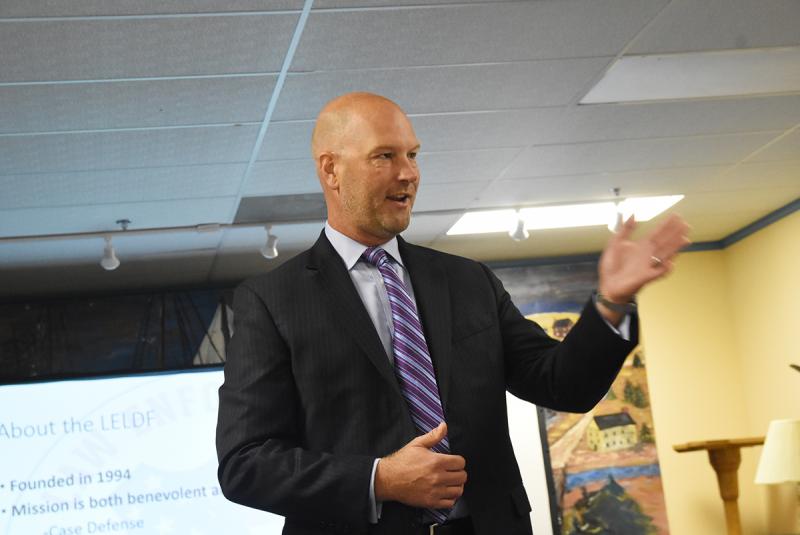You arrive at a suburban home to find two brothers fighting in the front yard. Family members are yelling and screaming 20 feet away. One brother runs into the home, and a police officer tries to calm down the other.
The first brother returns with a knife and holds it to the throat of an uninvolved family member. The other brother reacts by trying to fight the police officer. A scuffle ensues. Then, suddenly, the first brother – knife in hand – sprints toward his brother and the police officer. What do you do?
That’s one of several scenarios elected officials, media and community leaders experienced as participants in a state-of-the-art police use-of-force simulator Oct. 9 at Beacon Motel. The simulator was brought to Lewes by the Law Enforcement Legal Defense Fund, a nonprofit based in Washington, D.C. The group provides aid in cases where it finds police officers have been wrongfully charged in connection with their work in the line of duty. The group also provides education to the community about challenges facing law enforcement officers.
“This is one of the most important things I do in my work – outreach,” said Bill Gleason, a 30-plus-year law enforcement veteran. “Having this dialogue, giving the public a better understanding of what these use-of-force decisions are like, how fast they have to happen and getting feedback. Ultimately, we want to enhance the relationship and trust between police departments and their community.”
Similar scenarios involve a disgruntled former employee sitting in a car outside the business, a group of young men allegedly shooting paintballs in a rural area, and a man who matches the description of a suspect walking down the street.
In each scenario, something unexpected happens, and participants must make split-second decisions to use force or to hold off.
In the scenario with the disgruntled employee, the man exits his vehicle and walks with his back to officers toward the entrance of his former workplace with a gun against his head. In the scenario, if the participants watching him do nothing, he walks into the business and starts shooting.
Other situations have different outcomes. The man who matches the description of a person of interest is verbally abusive toward police officers. Then, he reaches into his pocket and pulls out his cellphone. In the simulation, some participants took action before seeing the phone.
“These decisions are made in situations that are tense, uncertain and rapidly evolving,” Gleason said. “They’re life-and-death decisions you have to make in a split second.”
Officers don’t always make the right decision, but their actions must be objectively reasonable, he said.
“A police officer’s force must be judged from the perspective of a reasonable officer on the scene at the time the force was used,” he said, noting a 1989 Supreme Court ruling set the legal standard.
He said an incident should not be judged with 20-20 hindsight.
“In reality, what do we do?” he said. “We watch the news, and we obviously view it with 20-20 hindsight. But that’s not the legal standard.”
Gleason said 12 percent to 15 percent of officer-involved shootings involve unarmed subjects.
“No officer ever wants to do that,” Gleason said. “But when we look at it, we have to determine if the officer reasonably believed at the time that the suspect posed an imminent threat of death or serious injury to the officer or another person.”
He said the public expects officers to remember everything, see everything and have a perfect memory of the incident. It’s scientifically impossible, he said.
“Officers succumb to the same physiological responses to stress as everybody else,” he said. “It’s absolutely normal to not see or hear everything.”
Some physiological effects officers may encounter include tunnel vision, memory distortion, auditory blockage and cognitive impairment.
The best way to understand a police officer’s decision is to experience it, Gleason said.
“Officers are not trained to shoot to kill,” Gleason said. “When we do unfortunately have to use deadly force, our officers are immediately rendering aid to that person to save their life seconds after they tried to take our life or someone else’s life.”
The Law Enforcement Legal Defense Fund does not defend all police-involved shootings. It uses a careful analysis to identify cases. Its board of directors makes the final decision on whether to support a case.
Gleason was called upon to analyze a case in Chicago where a 17-year-old African-American man was fatally shot 16 times. Gleason said the man was under the influence of PCP, had a knife and turned toward officers.
Gleason said he was able to justify the first shot, but he could not justify the 15 other shots.
Multiple shots are taken in some cases, he said, because a situation evolves and is sometimes chaotic. Most shootings are within 10 to 15 feet of a suspect, he said, but suspects are often moving. The average hit percentage, he said, is 25 percent.
That’s also why officers are trained to shoot at a suspect’s torso.
“That is the largest target area,” he said. “We’re not trying to shoot someone in the heart or aim for their head. We are just trying to stop them from their assaultive behavior toward us.”
A common myth, he said, is that some police officers relish the moment they get to use their firearm.
“Nobody wants to shoot to kill,” he said. “I deal with officers after they’re involved in shootings. I see what it does to them. I see what it does to their family. I always say police-involved shootings are a tragedy for everyone involved.”
Gleason said he’s done more than 75 debriefings following officer-involved shootings. Some officers will retire, while others will never go back out on the street. Some have psychological issues for the rest of their lives, he said.
“I’ve been shot at before, and I will tell you it’s not a good feeling,” he said.
He said there were 882,000 use-of-force incidents in 2018. While that sounds like a lot, he said, 98 percent of calls require no use of force.
A total of 46 law enforcement officers were fatally shot in 2017. It rose to 53 in 2018, he said.
“That’s a concern to us,” he said. “We want officers to be safe. Obviously, we don’t want officers involved in shootings if we can avoid it. I always say the two best weapons a police officer is armed with are their brain and their mouth. Try to talk down a situation if you can.”
Lewes police host meet and greet
Nearly the entire Lewes police force welcomed the public to the Margaret H. Rollins Community Center Oct. 9 for a fall meet and greet. Chief Tom Spell, Lt. James Azato and others explained officers’ daily tasks and duties, presented a brief history of the department and reviewed the equipment officers carry on their person and in their vehicles.
A highlight of the night was a K-9 demonstration by officer Tyrone Woodyard and his dog Blue. Before the meeting, Det. Jonathan Moyer hid marijuana in the room. After bringing Blue into the building, Woodyard led him around the room until he quickly found the drugs.
Nick Roth is the news editor. He has been with the Cape Gazette since 2012, previously covering town beats in Milton and Lewes. In addition to serving on the editorial board and handling page layout, Nick is responsible for the weekly Delaware History in Photographs feature and enjoys writing stories about the Cape Region’s history. Prior to the Cape Gazette, Nick worked for the Delmarva Media Group, including the Delaware Wave, Delaware Coast Press and Salisbury Daily Times. He also contributed to The News Journal. Originally from Boyertown, Pa., Nick attended Shippensburg University in central Pennsylvania, graduating in 2007 with a bachelor’s degree in journalism. He’s won several MDDC awards during his career for both writing and photography. In his free time, he enjoys golfing, going to the beach with his family and cheering for Philadelphia sports teams.

























































